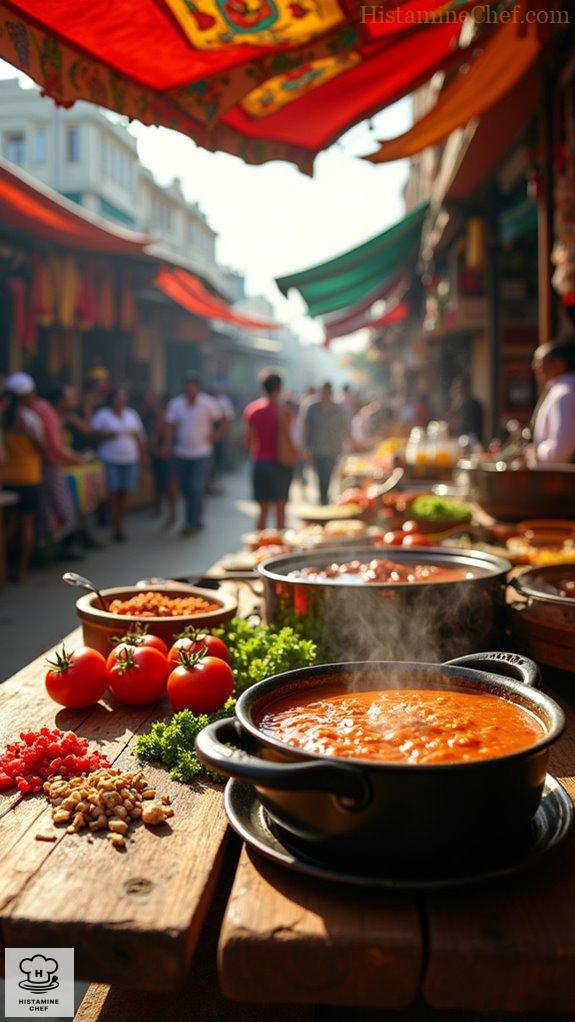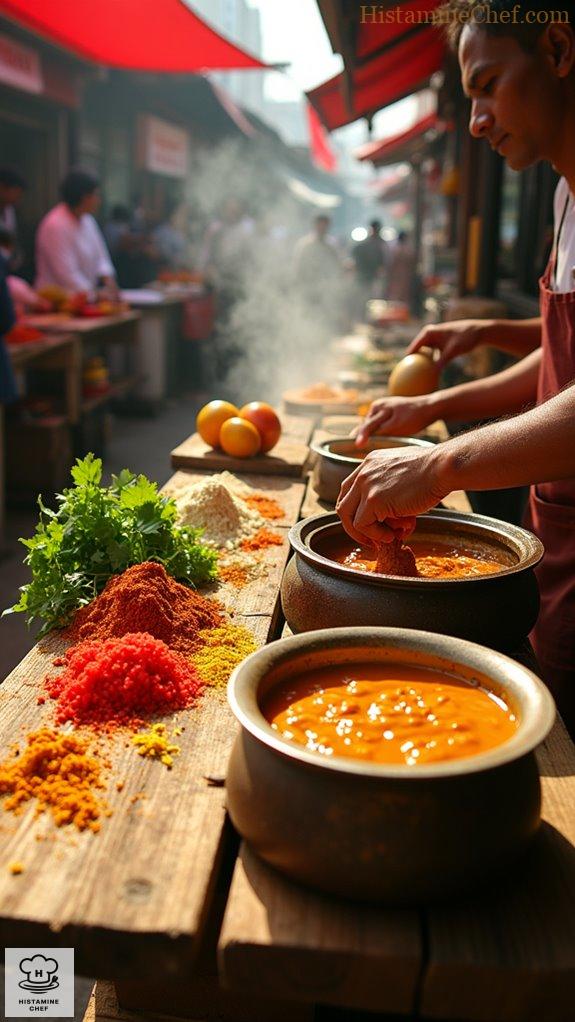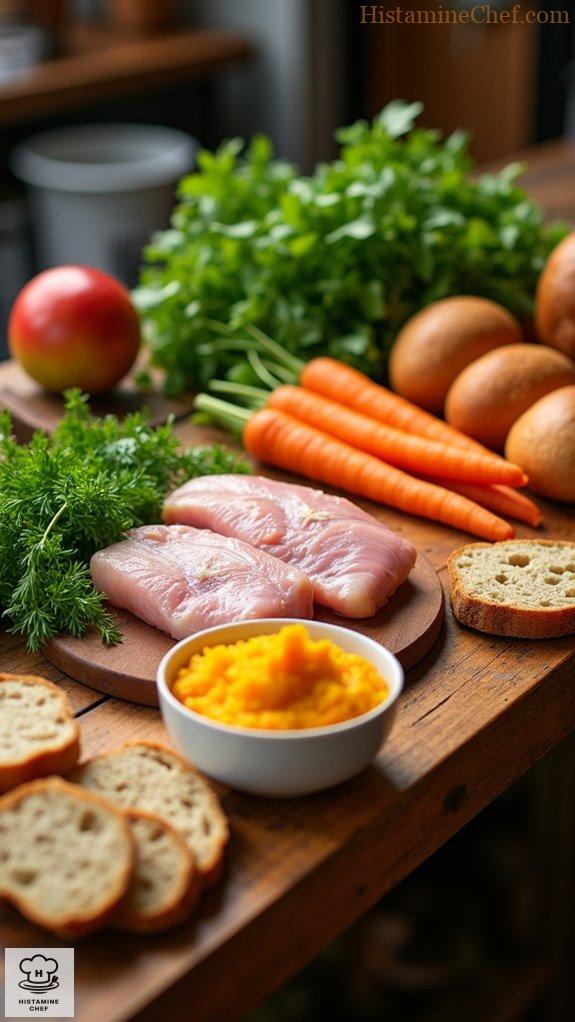If you’re craving homemade South African chow without the histamine hangover, you’re in for a treat! Imagine this: tender chicken nestled in a fluffy hollowed-out spelt bread, drizzled with sweet mango puree instead of tomato chutney. You can sauté fresh veggies, infusing it all with safe, zesty herbs. It’s all about that spicy curry magic without the dreaded inflammatory effects! Curious about how to whip this up in your kitchen? Stick around for some tips and tricks!
Vibrant Urban Culture Here

South Africa’s vibrant urban culture, particularly in cities like Durban, is deeply intertwined with its rich street food scene, a reflection of the country’s diverse culinary heritage.
Street food has evolved over generations, influenced by various cultural practices brought by different communities, including Indigenous, Indian, and colonial settlers. In Durban, one can find an array of tantalizing options such as bunny chow, a hollowed-out loaf filled with spicy curry, showcasing the fusion of flavors that typify South African cuisine.
The popularity of street food in urban centers speaks to the resilience and creativity of local vendors who transform simple ingredients into mouth-watering dishes that cater to the city’s multicultural palate. This urban culture has emerged from the defeat of Black polities in the 19th century, which reshaped local economies and settlement patterns.
Historically, street food has provided both sustenance and a sense of community, with markets and stalls serving as social hubs where residents connect over shared meals.
This culinary tradition not only contributes to the economy but also reinforces communal ties, making street food an essential element of Durban’s vibrant urban identity.
Spicy Curry in Hollowed Bread

Street vendors cooking Homemade South African Chow typically set up their stalls equipped with portable gas cookers and large pots to prepare the curry and oven-like setups to bake the hollowed bread on-site.
They start by mixing fresh dough for the bread using a combination of bread flour and all-purpose flour, ensuring perfect consistency. Once kneaded and allowed to rise, they shape the dough into balls and let them rise a second time.
Meanwhile, they chop fresh onions, garlic, and ginger, sautéing them in a large pot before adding spices and protein. The curry simmers until thickened, while the bread bakes in a makeshift oven with steam to create that ideal crust.
Once the bread is ready, they hollow it out and fill it generously with the flavorful curry filling, serving it hot and fresh to hungry customers.
Ingredients Needed:
- 500g bread flour
- 250g all-purpose flour
- 1 packet (7g) dry yeast
- 200g onion, chopped
- 200g chicken thighs, cubed
- 200g tomatoes, diced
- 50g curry powder
- Fresh coriander for garnish
Cooking Steps:
- Mix flours, yeast, salt, and warm water.
- Knead until soft and non-sticky.
- Allow dough to rise for 2 hours.
- Shape dough into balls and rest.
- Sauté onions, garlic, and ginger until translucent.
- Add spices and chicken, cook thoroughly.
- Simmer curry until thickened to preference.
- Hollow bread and fill with curry.
Make a Basic Curry

To make a basic South African chow, start by preparing your vegetables, ensuring they’re all allowed on the SIGHI list.
Use chicken or beef as your protein, and choose allowed spices like turmeric and coriander for flavoring. Instead of using restricted chili peppers, opt for a milder spice combination, adjusting the heat to taste.
Cook the meat in a large pot with extra virgin olive oil until browned, then add your chopped vegetables, sauté until softened, and stir in the spices.
Add water or broth to create a stew-like consistency, allow it to simmer, and serve with rice or another allowed starch for a hearty meal.
- Use fresh, allowed veggies.
- Opt for chicken or beef protein.
- Choose allowed spices only.
- Sauté with extra virgin olive oil.
- Simmer with broth or water.
- Serve with rice or quinoa.
- Adjust spice heat to taste.
Low Histamine Variation of Bunny Chow

Histamine intolerance can pose challenges for individuals, especially when it comes to enjoying street food. Many street foods are prepared using ingredients that are high in histamine or liberators, which can lead to adverse reactions for sensitive individuals.
It’s vital to be aware of the SIGHI list to make informed food choices.
Eating street food like Bunny Chow can be problematic for those with histamine intolerance due to ingredients such as tomatoes, pickled vegetables, and fermented products that are restricted per the SIGHI list. These components can provoke symptoms like headaches, gastrointestinal issues, or allergic reactions, making alternative preparation crucial for safe enjoyment.
Instructions for Low Histamine Bunny Chow:
- Use fresh chicken instead of marinated or processed meats for filling.
- Replace tomato chutney with pureed apples or mango for flavor.
- Skip the use of traditional spices, using only safe herbs.
- Cook bread from allowed starches like spelt or rice instead of regular.
- Avoid pickled vegetables; use fresh, allowed vegetables instead.
- Replace yeast-based or long-fermented bread with fresh bread.
- Use extra virgin olive oil for cooking instead of any restricted oils.
- Serve with a side of fresh cucumber or carrot sticks for crunch.
- Guarantee no canned or processed ingredients are included in preparation.
- Maintain cleanliness and avoid cross-contamination to keep histamine low. Implementing smart cooking techniques can further enhance the low histamine nature of your meals.
Video Summary
Chow is a traditional South African dish, often enjoyed as a street food staple. In this video, we’ll show you both the authentic street version and a home-friendly low histamine option.
Street vendors prepare chow with a fierce sense of pride. They start by marinating fresh chicken pieces in a blend of spices, including chili and mustard. This marinated chicken is then grilled over an open flame, ensuring a smoky flavor.
Once cooked, the chicken is tossed with sautéed onions and tomatoes. The vendors serve it piping hot, garnished with fresh herbs and spicy sauces. The smell is irresistible, inviting customers from all around.
Now, let’s switch to our home version of chow with low histamine adjustments. Begin by using freshly cooked chicken breast instead of marinated chicken. Skip the soy sauce and remove any added chili.
Instead of onions, try using carrot and fresh herbs like parsley for flavor. Cook the chicken in a pan, using extra virgin olive oil for sautéing. Add the diced carrot and allow it to cook until softened.
For the garnish, opt for chopped parsley instead of spicy sauces.
You can serve this delightful dish with quinoa instead of traditional starches. The meal visually resembles the original with vibrant colors but offers a much milder taste. Click the link in the description for the full recipe and enjoy your homemade chow!
Questions and Answers
What Is Bunnie Chow Traditionally Served With?
Bunny chow’s traditionally served with a rich curry filling, often accompanied by sambals like chopped onions, carrots, and chilies. I love how these toppings enhance the dish, bringing vibrant flavors and satisfying textures to every bite.
Can I Use Leftover Curry for Bunny Chow?
Using leftover curry for Bunny Chow saves time and reduces waste. Did you know that 40% of food goes uneaten? So, why not transform that delicious curry into a satisfying, hearty meal?
How Can I Store Homemade Bunny Chow?
Storing homemade bunny chow’s easy! I let it cool, then place it in an airtight container. I keep it in the fridge for up to three days or freeze portions for later enjoyment. Enjoy your meal!
What Type of Bread Is Best for Bunny Chow?
When choosing bread, you’ve got options, but the key? Opt for sturdy loaves. I’ve found crusty white or whole grain works best, ensuring they hold all the delicious fillings without falling apart. Trust me.
Is Bunny Chow Suitable for Vegetarian Diets?
Absolutely, bunny chow can be tailored to vegetarian diets. I often swap meat with hearty vegetables or legumes, creating a deliciously satisfying dish that still maintains its essence and flavor. You’ll love the versatility!
References
- https://www.britannica.com/place/South-Africa/Urban-settlement
- http://mit.edu/~ecprice/Public/freq/googlelist.counts
- https://www.supernovamagazine.co.za/urban-cultures/
- https://www.lingexp.uni-tuebingen.de/z2/Morphology/baroni.rows
- https://fwdeklerk.org/urbanisation-in-south-africa/
- https://chowdown858479102.wordpress.com/2020/06/27/bunny-chow-in-a-homemade-bread-bowl-recipe/
- https://www.africanbites.com/bunny-chow/
- https://www.simplysensationalfood.com/2012/12/bunny-chow-south-african-stew-in-bread.html


Leave a Reply